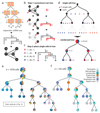Simultaneous lineage tracing and cell-type identification using CRISPR-Cas9-induced genetic scars
- PMID: 29644996
- PMCID: PMC5942543
- DOI: 10.1038/nbt.4124
Simultaneous lineage tracing and cell-type identification using CRISPR-Cas9-induced genetic scars
Abstract
A key goal of developmental biology is to understand how a single cell is transformed into a full-grown organism comprising many different cell types. Single-cell RNA-sequencing (scRNA-seq) is commonly used to identify cell types in a tissue or organ. However, organizing the resulting taxonomy of cell types into lineage trees to understand the developmental origin of cells remains challenging. Here we present LINNAEUS (lineage tracing by nuclease-activated editing of ubiquitous sequences)-a strategy for simultaneous lineage tracing and transcriptome profiling in thousands of single cells. By combining scRNA-seq with computational analysis of lineage barcodes, generated by genome editing of transgenic reporter genes, we reconstruct developmental lineage trees in zebrafish larvae, and in heart, liver, pancreas, and telencephalon of adult fish. LINNAEUS provides a systematic approach for tracing the origin of novel cell types, or known cell types under different conditions.
Conflict of interest statement
The authors declare no competing financial interests.
Figures



Comment in
-
Tracing cell-lineage histories.Nat Rev Genet. 2018 Jun;19(6):327. doi: 10.1038/s41576-018-0015-0. Nat Rev Genet. 2018. PMID: 29713013 No abstract available.
References
Publication types
MeSH terms
Grants and funding
LinkOut - more resources
Full Text Sources
Other Literature Sources
Molecular Biology Databases

